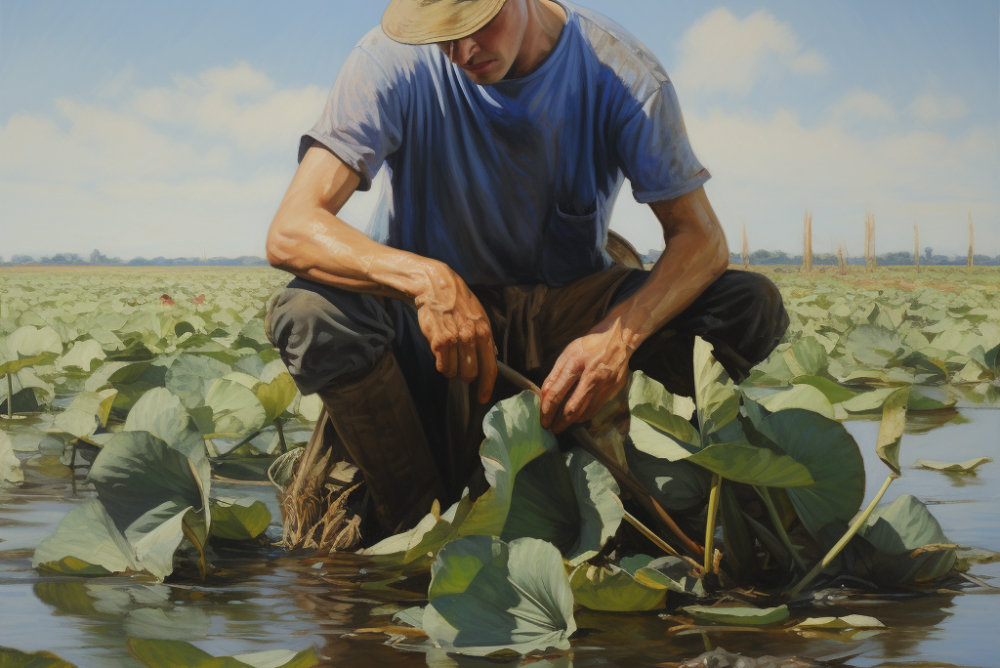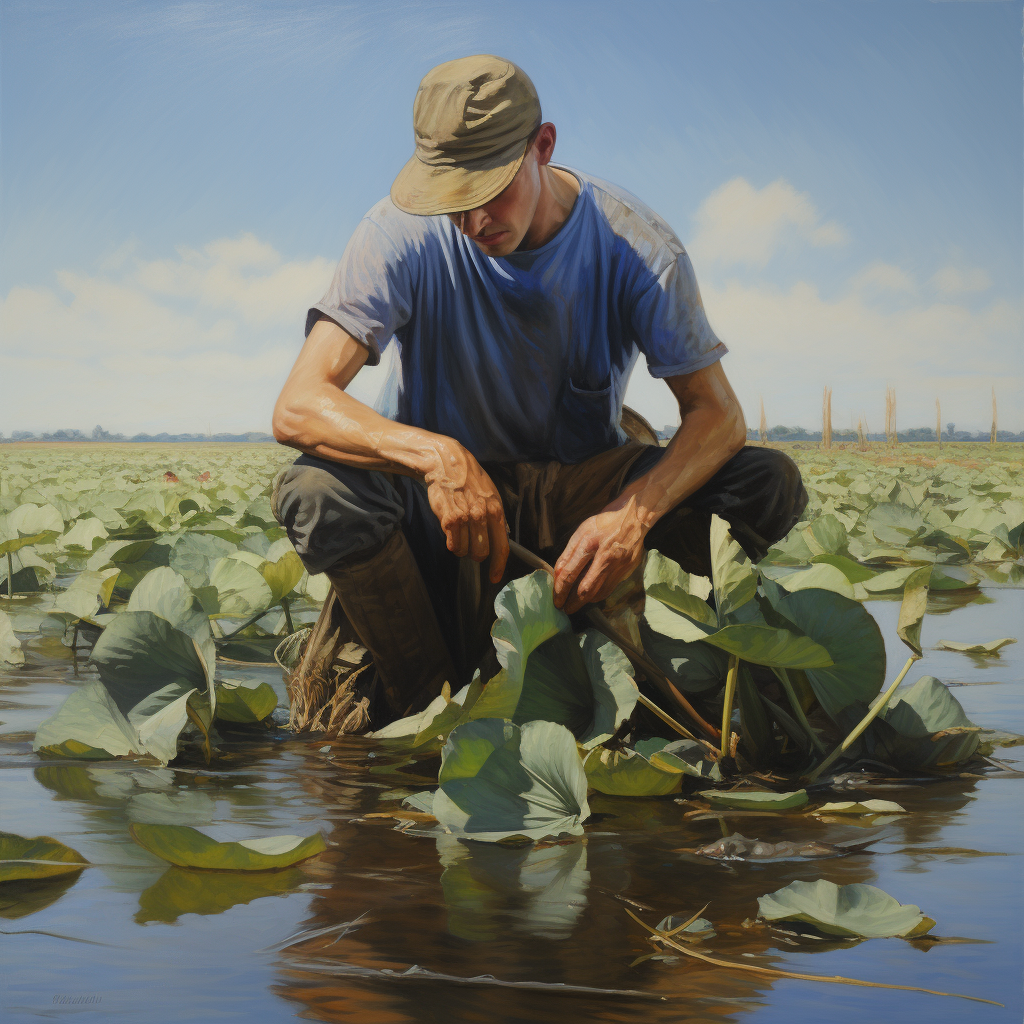Harnessing Water Hyacinth: A Sustainable Revolution in Fashion


Water hyacinth, a fast-growing aquatic plant, has often been viewed as a threat to aquatic ecosystems due to its invasive nature. However, in recent years, an innovative shift in perspective has led to the discovery of its potential as a sustainable material for fabric development. This article delves into the process, benefits, and challenges of creating organic and sustainable fabric from water hyacinth, and its implications for the fashion industry and our environment.
The rise of sustainable fashion has led to the exploration of various natural resources for fabric production, and water hyacinth stands out as a promising candidate. This plant, with its rapid growth and high cellulose content, offers a unique and renewable source of fiber, transforming an ecological problem into a sustainable solution.
This shift towards sustainable and organic materials not only aligns with the global trend of environmental consciousness but also presents a novel way to manage the proliferation of water hyacinth. This plant, native to the Amazon basin, has spread to various parts of the world, becoming an ecological concern due to its aggressive growth and the resultant negative effects on water bodies.
Water Hyacinth: An Overview
Water hyacinth, scientifically known as Eichhornia crassipes, is a free-floating perennial aquatic plant native to South America. With its attractive lavender flowers and broad, glossy leaves, it is often used for ornamental purposes in ponds and lakes. But don't let its beauty fool you. Behind the pretty facade lies an aggressive invader that, due to its rapid growth rate, can quickly overrun water bodies, leading to significant ecological and economic problems.
The plant can double its population in just two weeks, forming dense mats that cover the entire water surface. These mats, while providing habitat for some wildlife species, can block sunlight and oxygen, dramatically altering the aquatic environment and impacting other plant and animal species. They also pose challenges for navigation, fishing, and water management operations.
Despite these problems, water hyacinth is not all bad. It possesses qualities that make it a potentially valuable resource. One of these is its high cellulose content (about 60%), which makes it suitable for paper and textile production. Also, the plant's rapid growth means it can provide a continuous supply of raw material, making it a sustainable option for fabric production.
Moreover, water hyacinth has been used in phytoremediation, a process where plants are used to remove or neutralize contaminants in soils, sludges, sediments, surface water, and groundwater. It has the ability to absorb heavy metals and other pollutants, making it useful for cleaning up polluted water bodies.
The Process of Turning Water Hyacinth into Fabric
The process of converting water hyacinth into fabric is a fascinating blend of traditional techniques and modern innovations. The first step is the harvesting of the water hyacinth, a task that requires careful planning and execution, given the plant's rapid growth rate and invasive nature.
Once harvested, the plants are left to dry under the sun for several days to reduce moisture content. This natural drying process is environmentally friendly as it doesn't involve energy consumption or the release of greenhouse gases.
The dried water hyacinths are then subjected to a process known as retting, a method commonly used in the production of natural fibers. Retting involves soaking the plants in water for a period to facilitate the removal of the non-fibrous material. Once retted, the water hyacinths are again dried.
The next step in the process is decortication, which involves removing the outer bark or husk to extract the fibrous material inside. This is typically done using hand-operated decorticators, further emphasizing the environmentally friendly nature of this process.
The extracted fibers are then cleaned and spun into yarn using traditional spinning wheels. This yarn can then be dyed using natural dyes, adding another layer of sustainability to the process.
Finally, this yarn is woven into fabric using looms. The end product is a durable, organic, and sustainable fabric that can be used in a variety of applications, including clothing, home furnishings, and accessories.
The entire process, from harvesting to weaving, focuses on sustainability and minimal environmental impact. By utilizing traditional techniques and focusing on manual labor, the production of water hyacinth fabric provides employment opportunities, boosts local economies, and promotes sustainable practices.
The Benefits of Using Water Hyacinth Fabric
The use of water hyacinth for fabric production offers numerous benefits, spanning environmental, economic, and social spheres.
Environmental Benefits
The primary environmental benefit of water hyacinth fabric lies in its sustainability. As a rapidly renewable resource, water hyacinth can provide a continuous supply of raw material for fabric production, reducing reliance on non-renewable resources such as petroleum-based products for synthetic fabric production.
Moreover, the production process of water hyacinth fabric is low-impact, involving minimal energy consumption and pollution. It also helps in controlling the overpopulation of water hyacinth in water bodies, thereby mitigating its detrimental effects on aquatic ecosystems.
Economic Benefits
From an economic perspective, water hyacinth fabric can contribute to local economies by creating employment opportunities. The production process, which involves harvesting, drying, retting, decortication, spinning, dyeing, and weaving, requires substantial manual labor, providing jobs in areas where water hyacinth is abundant.
Social Benefits
The use of water hyacinth fabric also promotes social good. By providing employment opportunities, it can contribute to poverty alleviation in regions affected by water hyacinth overpopulation. Moreover, the production of water hyacinth fabric can empower communities by promoting traditional skills and crafts.
Aesthetic and Functional Benefits
Water hyacinth fabric possesses unique aesthetic and functional qualities. It has a rich, natural texture and a pleasing earthy tone, making it suitable for a range of applications, from fashion to home decor. Functionally, the fabric is durable, breathable, and comfortable to wear.
The Role of Organic and Sustainable Water Hyacinth Fabric in the Fashion Industry
The fashion industry, a significant contributor to global pollution, has been undergoing a sustainability revolution in recent years. Consumers are becoming increasingly aware of the environmental impact of their clothing choices, leading to a surge in demand for sustainable and ethically produced garments. In this context, water hyacinth fabric presents a compelling alternative to traditional materials.
A Sustainable Alternative
Water hyacinth fabric, with its renewable nature and low-impact production process, aligns with the principles of sustainable fashion. It offers a viable alternative to synthetic materials, which are petroleum-based and contribute to pollution and resource depletion.
Unique Aesthetic Appeal
The unique aesthetic qualities of water hyacinth fabric, including its natural texture and earthy tone, appeal to designers seeking to differentiate their creations. This fabric lends itself to a variety of styles, from rustic to sophisticated, making it a versatile choice for designers.
Comfort and Durability
In addition to its environmental and aesthetic benefits, water hyacinth fabric offers functional advantages. Its comfort and breathability make it suitable for a wide range of garments, including dresses, shirts, and jackets. Its durability also ensures longevity, a key factor in sustainable fashion.
Promoting Local Craftsmanship
The use of water hyacinth fabric in fashion can help preserve and promote traditional skills and craftsmanship. The production process involves techniques such as hand-spinning and hand-weaving, which can be highlighted as unique selling points in the fashion industry.
Challenges and Solutions in Water Hyacinth Fabric Production
While the concept of water hyacinth fabric is promising, several challenges need to be addressed to successfully integrate it into the mainstream textile and fashion industry.
Scaling Production
One of the most significant challenges is scaling production. Currently, most of the water hyacinth fabric production is small-scale and localized. Transforming this into a large-scale industry without compromising its sustainability principles presents a considerable challenge.
Solution: Collaboration between different stakeholders — local communities, governments, non-profit organizations, and private enterprises — can help scale up production. Investments in infrastructure, training, and technology can enable more efficient and sustainable production methods without losing the craft's traditional essence.
Quality Consistency
Maintaining consistent quality is another challenge. Factors such as variations in water hyacinth quality, manual processing techniques, and lack of standardized production protocols can lead to inconsistencies in the final product.
Solution: Implementing quality control measures and developing standardized production protocols can ensure consistent product quality. Training artisans in best practices can also help improve quality consistency.
Market Acceptance
Market acceptance of water hyacinth fabric is another hurdle. Despite growing awareness of sustainable fashion, consumers may be hesitant to switch to less-known materials like water hyacinth fabric.
Solution: Awareness campaigns emphasizing the environmental, social, and aesthetic benefits of water hyacinth fabric can help increase its market acceptance. Collaborations with fashion designers and brands can also help introduce the material to a broader audience.
Despite these challenges, the potential of water hyacinth fabric is immense. As we continue to seek sustainable and ethical alternatives in fashion, innovative solutions like water hyacinth fabric can lead the way.
Conclusion
The journey of water hyacinth from being an invasive aquatic plant to a potential game-changer in the fashion industry is a compelling example of innovative thinking and sustainable practices. Despite the challenges it presents, the water hyacinth plant offers a unique opportunity to turn an ecological problem into a sustainable solution.
The production of water hyacinth fabric aligns with the growing demand for environmentally friendly and ethically produced materials in the fashion industry. It offers a sustainable alternative to synthetic fabrics, reduces the environmental impact of the textile industry, and contributes to local economies by creating employment opportunities.
However, realizing the full potential of water hyacinth fabric requires addressing challenges related to scaling production, maintaining quality consistency, and ensuring market acceptance. This calls for collaboration among various stakeholders, including local communities, governments, non-profit organizations, and the private sector.
As consumers, we have a crucial role to play in promoting sustainable fashion. By choosing products made from sustainable materials like water hyacinth fabric, we can contribute to environmental conservation and social good.
In conclusion, water hyacinth fabric represents a promising path towards a more sustainable future. It embodies the principle that solutions to some of our most pressing environmental challenges may be found in nature itself. As we continue to innovate and explore sustainable practices, we can look forward to more such discoveries that benefit both our planet and its inhabitants.





-500x500.jpg)
-500x500.jpg)
-500x500.jpg)
-500x500.jpg)
-500x500.jpg)